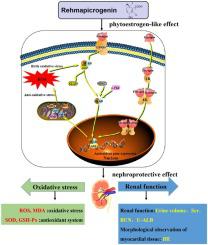Biomedicine & Pharmacotherapy ( IF 6.9 ) Pub Date : 2021-04-02 , DOI: 10.1016/j.biopha.2021.111305 Mengmeng Wang 1 , Yingying Ke 1 , Yage Li 1 , Zengfu Shan 1 , Wangyang Mi 1 , Yangang Cao 1 , Weisheng Feng 2 , Xiaoke Zheng 2

|
Background
The root of Rehmannia glutinosa (R. glutinosa) is commonly used in various traditional Chinese herbal formulae to ameliorate nephropathy; however, little is known about its active component(s) and mechanisms.
Aim
In the present study, we examined the protective effect and potential mechanism of rehmapicrogenin, a monomeric compound extracted from R. glutinosa, against Adriamycin (ADR)-induced nephropathy (AN) in vivo and in vitro.
Methods
In this study, an ADR-induced kidney injury model was employed to investigate the nephroprotective effects of rehmapicrogenin in mice. In vivo, ELISA kits, flow cytometry, haematoxylin-eosin staining, immunofluorescence techniques, and western blotting were used to evaluate the effect of rehmapicrogenin on kidney injury in mice. In vitro, the effects of rehmapicrogenin on NRK-52E cellular damage induced by ADR were determined using the 3-(4,5-dimethylthiazolyl-2-yl)-2,5-diphenyltetrazolium bromide (MTT) method. The mechanism was investigated using ELISA kits, flow cytometry and In-Cell Western™ blotting.
Results
In vivo, rehmapicrogenin treatment significantly attenuated the pathological changes in the kidney induced by ADR; rescued weight, serum creatinine (Scr), blood urea nitrogen (BUN) and urine albumin (U-ALB) levels; reduced reactive oxygen species (ROS) accumulation; and decreased oxidative stress, the apoptosis rate, and cell survival in ADR-treated mice. Importantly, both in vivo and in vitro experimental results demonstrated that rehmapicrogenin regulates the Nrf2/ARE signalling pathway, the most important pathway for oxidative stress. Rehmapicrogenin attenuated ADR-induced kidney damage by reducing oxidative stress through the oestrogen receptor pathway. Moreover, after treatment with ICI 182780 (the oestrogen receptor-nonspecific antagonist Faslodex), the improvement induced by rehmapicrogenin was significantly reversed.
Conclusions
In conclusion, rehmapicrogenin attenuates kidney damage by reducing inflammatory factor release through the oestrogen signalling pathway.
中文翻译:

Rehmapicrogenin的肾脏保护作用和机制包括体内和体外通过雌激素样途径抑制ROS
背景
熟地黄(R. glutinosa)的根通常用于各种传统中草药配方中以改善肾病。然而,对其活性成分和机制知之甚少。
目的
在本研究中,我们检查了保护作用和rehmapicrogenin,从提取的单体化合物的潜在机制地黄,对阿霉素(ADR)诱导的肾病(AN)在体内和体外。
方法
在这项研究中,采用ADR诱导的肾脏损伤模型来研究rehmapicrogenin对小鼠的肾脏保护作用。在体内,使用ELISA试剂盒,流式细胞仪,苏木精-伊红染色,免疫荧光技术和Western印迹法来评估rehmapicrogenin对小鼠肾脏损伤的作用。在体外,使用3-(4,5-二甲基噻唑基-2-基)-2,5-二苯基四唑溴化物(MTT)方法测定了瑞克帕克罗丁菌素对ADR诱导的NRK-52E细胞损伤的影响。使用ELISA试剂盒,流式细胞仪和In-Cell Western™印迹对机理进行了研究。
结果
在体内,Rehmapicrogenin治疗可显着减轻ADR所致肾脏的病理变化。挽救体重,血清肌酐(Scr),血尿素氮(BUN)和尿白蛋白(U-ALB)水平;减少活性氧(ROS)积累;降低了ADR处理的小鼠的氧化应激,凋亡率和细胞存活率。重要的是,在体内和体外实验结果表明,rehmapicrogenin调节Nrf2 / ARE信号传导途径,这是氧化应激最重要的途径。Rehmapicrogenin通过减少通过雌激素受体途径的氧化应激而减轻了ADR诱导的肾脏损害。此外,在用ICI 182780(雌激素受体非特异性拮抗剂Faslodex)治疗后,rehmapicrogenin引起的改善显着逆转。
结论
总之,Rehmapicrogenin通过减少通过雌激素信号传导途径释放的炎症因子来减轻肾脏损害。





















































 京公网安备 11010802027423号
京公网安备 11010802027423号